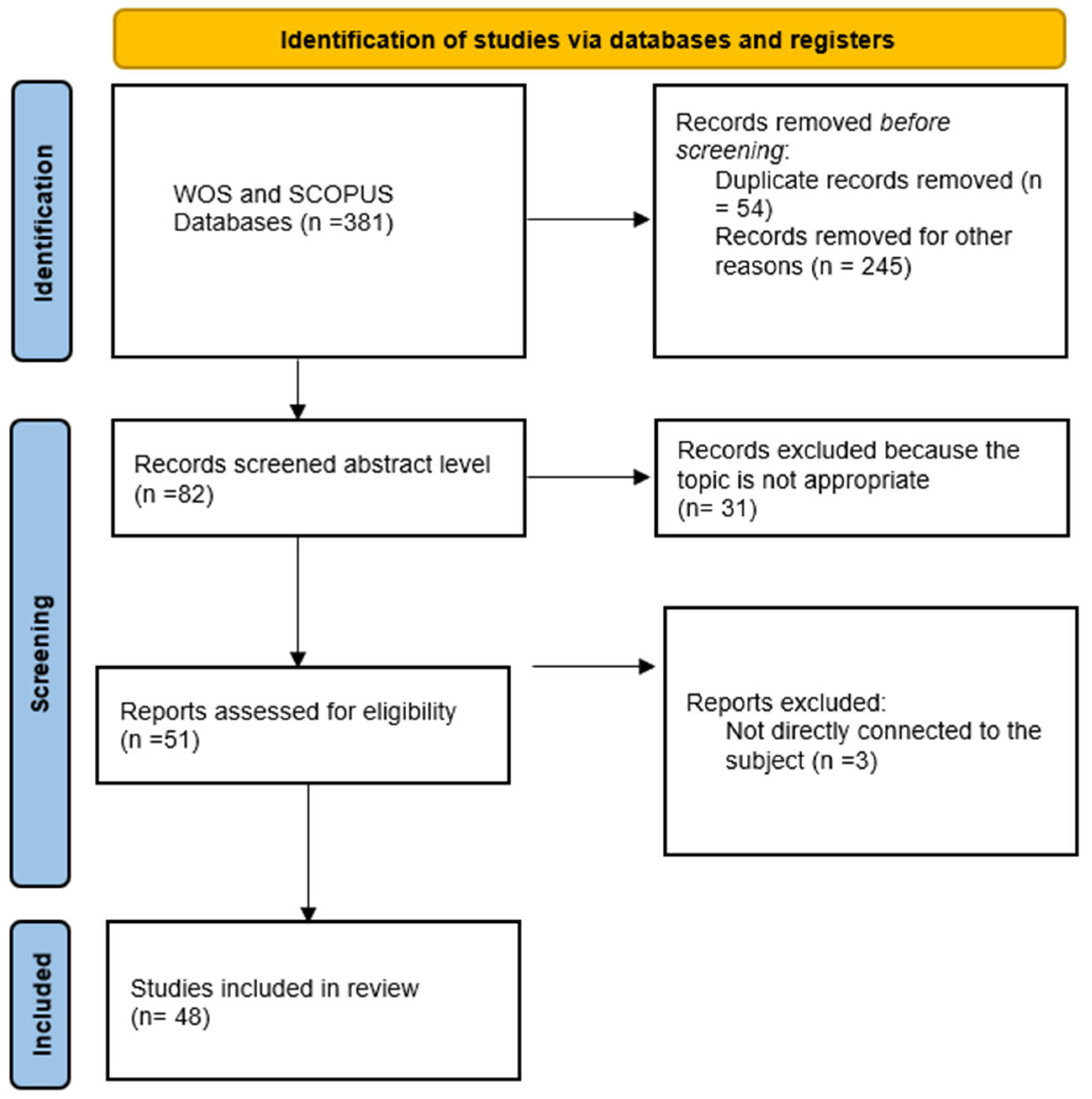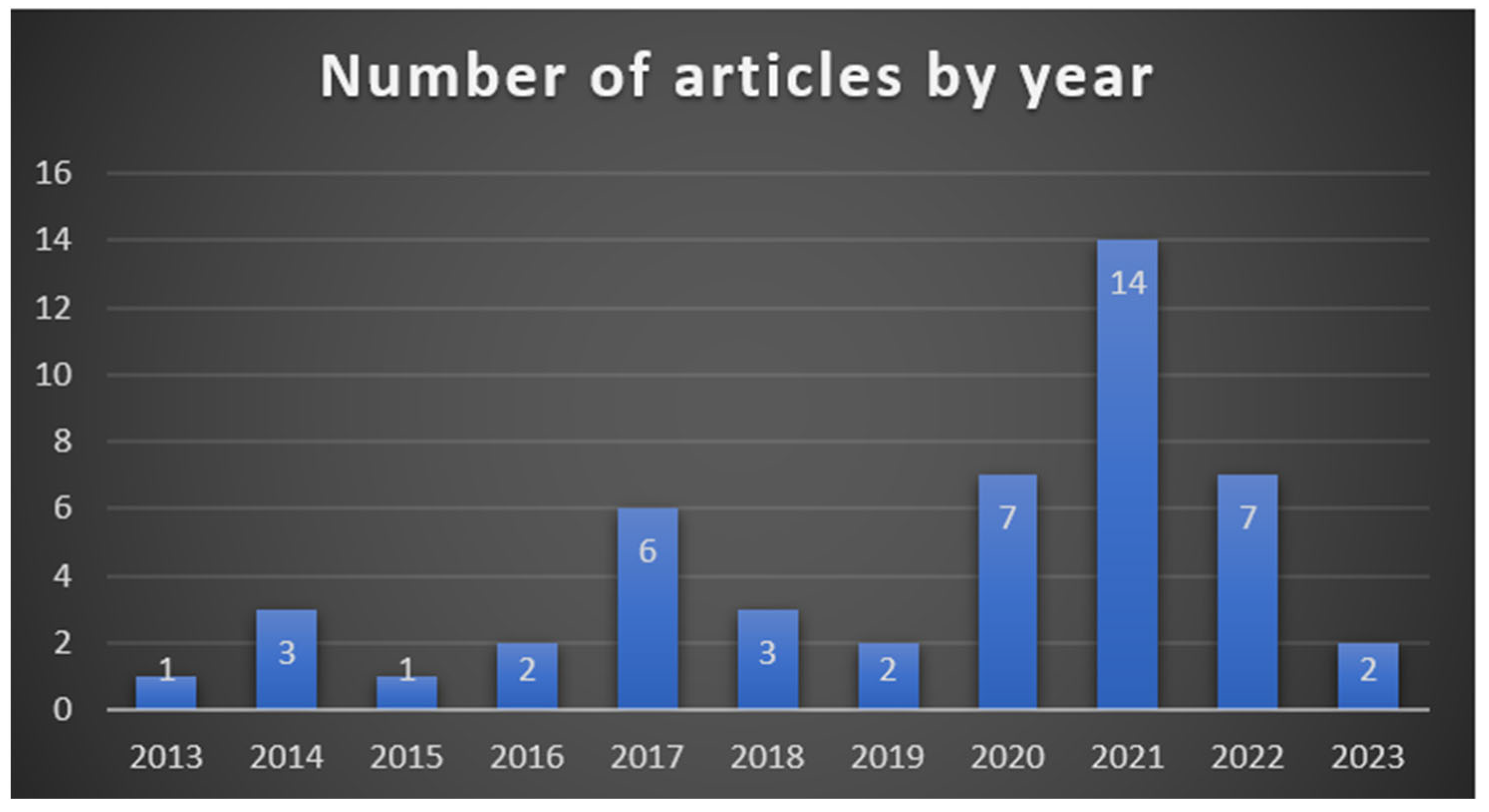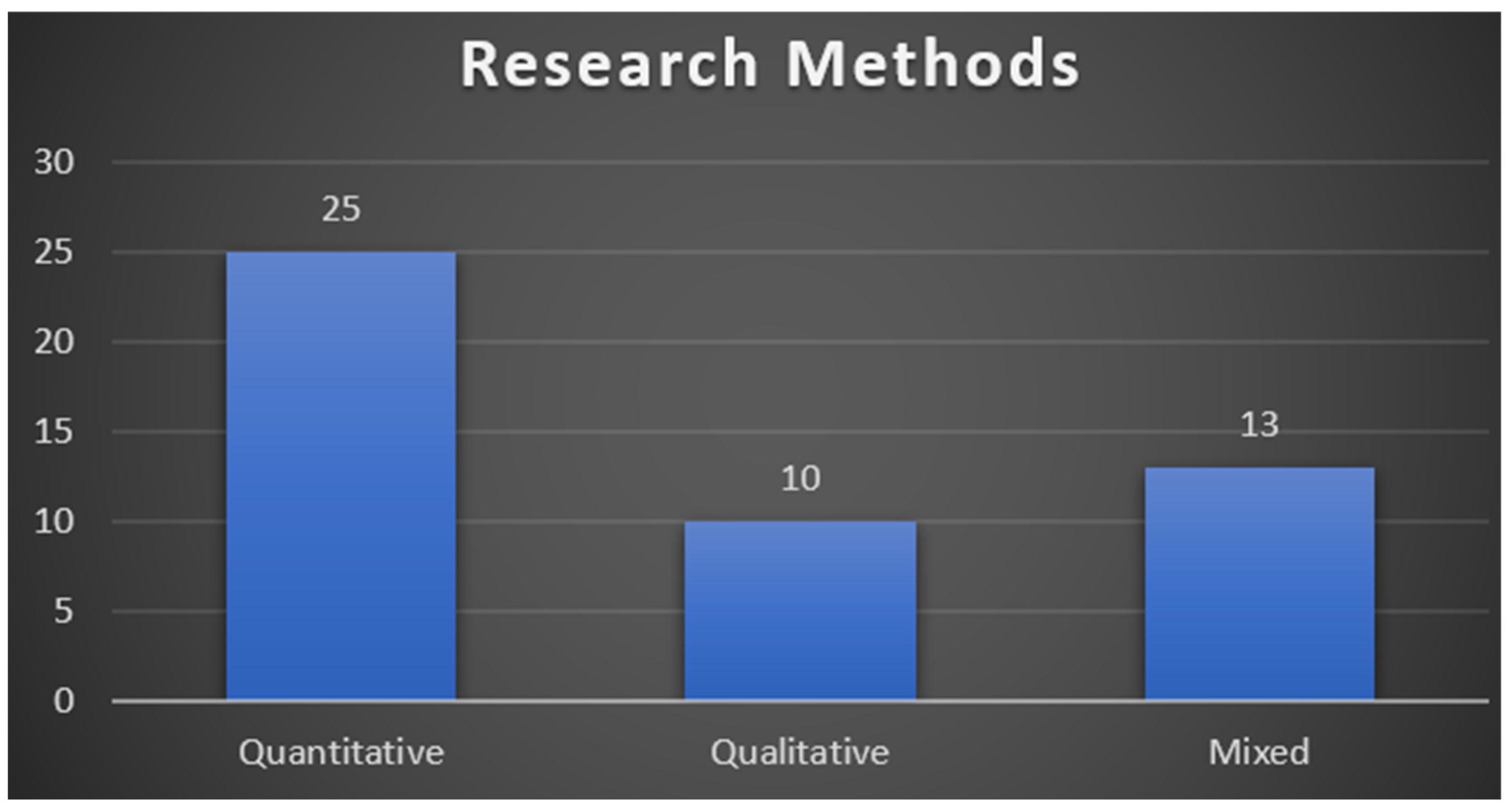Positive and Negative Impacts of Gamification on the Fitness Industry
Abstract
1. Introduction
- -
- What are the positive and negative effects of using gamification applications for fitness?
- -
- What are the challenges of using gamification applications for fitness?
- -
- What are the recommendations for fitness gamification applications proposed by the literature?
2. Materials and Methods
2.1. Search Strategy
2.2. Inclusion and Exclusion Criteria
2.3. Descriptive Analysis of Articles
3. Results
3.1. Positive Effects of Gamification
3.2. Negative Effects of Gamification
3.3. Challenges of Gamification Usage in the Fitness
3.4. Recommendations for Fitness Gamification Applications Proposed by the Literature
- Understanding user motivations and social needs: Understanding users’ primary psychological motivators and social needs in designing gamified fitness apps [43].
- Data security: Improve user data security, as fitness apps typically capture user data. When third-party corporations or organizations track and store performance data, there is a danger that this data will be exploited or hacked somehow [14]. Therefore, there is a need to improve safety from data theft significantly.
- Usability improvements: Fixing technical issues and bugs to improve the usability of gamified fitness apps and make them more engaging [8].
- Gender inclusivity: Well-structured design of gamified apps in a way that appeals to both male and female users, especially in self-monitoring drivers [39].
- Personalization: Apps that deliver messages tailored to each individual to suggest realistic and individualized goals [44].
- Improved accessibility: Providing better access to clear and concise information and simplifying interaction with the app, especially for older adults, benefitting [45].
4. Discussion
5. Conclusions
Author Contributions
Funding
Institutional Review Board Statement
Informed Consent Statement
Data Availability Statement
Conflicts of Interest
References
- Lacombe, J.; Armstrong, M.E.; Wright, F.L.; Foster, C. The impact of physical activity and an additional behavioural risk factor on cardiovascular disease, cancer and all-cause mortality: A systematic review. BMC Public Health 2019, 19, 900. [Google Scholar] [CrossRef] [PubMed]
- Lee, I.-M.; Shiroma, E.J.; Lobelo, F.; Puska, P.; Blair, S.N.; Katzmarzyk, P.T.; Kahlmeier, S.; The Lancet Physical Activity Series Working Group. Effect of physical inactivity on major non-communicable diseases worldwide: An analysis of burden of disease and life expectancy. Lancet 2012, 380, 219–229. [Google Scholar] [CrossRef]
- WHO-Organization. Launch of New Global Estimates on Levels of Physical Activity in Adults. 2018. Available online: https://www.usatoday.com/story/news/nation-now/2018/09/05/adults-worldwide-not-exercising-study-who/1199978002/) (accessed on 22 May 2023).
- Health.Gov. Top 10 Things to Know about the Second Edition of the Physical Activity Guidelines for Americans. Physical Activity Guidlines, 2023. Available online: https://health.gov/our-work/nutrition-physical-activity/physical-activity-guidelines/current-guidelines/top-10-things-know (accessed on 27 May 2023).
- Fanaroff, A.C.; Patel, M.S.; Chokshi, N.; Coratti, S.; Farraday, D.; Norton, L.; Rareshide, C.; Zhu, J.; Szymczak, J.E.; Russell, L.B.; et al. A randomized controlled trial of gamification, financial incentives, or both to increase physical activity among patients with elevated risk for cardiovascular disease: Rationale and design of the be active study. Am. Heart J. 2023, 260, 82–89. [Google Scholar] [CrossRef] [PubMed]
- Ledger, D.; McCaffrey, D. Inside Wearables Part 1: How Behavior Change Unlocks Long-Term Engagement. 2017. Available online: https://medium.com/@endeavourprtnrs/inside-wearable-how-the-science-of-human-behavior-change-offers-the-secret-to-long-term-engagement-a15b3c7d4cf3 (accessed on 19 April 2023).
- Neupane, A.; Hansen, D.; Fails, J.A.; Sharma, A. The Role of Steps and Game Elements in Gamified Fitness Tracker Apps: A Systematic Review. Multimodal Technol. Interact. 2021, 5, 5. [Google Scholar] [CrossRef]
- Mustafa, A.S.; Ali, N.; Dhillon, J.S.; Alkawsi, G.; Baashar, Y. User Engagement and Abandonment of mHealth: A Cross-Sectional Survey. Healthcare 2022, 10, 221. [Google Scholar] [CrossRef] [PubMed]
- Jia, Y.; Liu, Y.; Yu, X.; Voida, S. Designing Leaderboards for Gamification. In Proceedings of the 2017 CHI Conference on Human Factors in Computing Systems, Denver, CO, USA, 6–11 May 2017; pp. 1949–1960. [Google Scholar] [CrossRef]
- Stancu, V.; Frank, D.; Lähteenmäki, L.; Grunert, K.G. Motivating consumers for health and fitness: The role of app features. J. Consum. Behav. 2022, 21, 1506–1521. [Google Scholar] [CrossRef]
- Zabonick-Chonko, R. Evaluate Your Readiness for New Group Exercise Programming. ClubSolutions. 2014. Available online: https://clubsolutionsmagazine.com/2014/08/evaluate-readiness-new-group-exercise-programming/ (accessed on 15 April 2023).
- Gonze, B.D.B.; Padovani, R.D.C.; Simoes, M.D.S.; Lauria, V.; Proença, N.L.; Sperandio, E.F.; Ostolin, T.L.V.D.P.; Gomes, G.A.D.O.; Castro, P.C.; Romiti, M.; et al. Use of a Smartphone App to Increase Physical Activity Levels in Insufficiently Active Adults: Feasibility Sequential Multiple Assignment Randomized Trial (SMART). JMIR Res. Protoc. 2020, 9, e14322. [Google Scholar] [CrossRef]
- Misra, S. New Report Finds More than 165,000 Mobile Health Apps Now Available, Takes Close Look at Characteristics & Use. iMedicalApps. 2015. Available online: https://www.imedicalapps.com/2015/09/ims-health-apps-report/ (accessed on 23 April 2023).
- Reisner, C. On the media practice of highscoring. Cogent Arts Humanit. 2016, 3, 1210277. [Google Scholar] [CrossRef]
- Saprikis, V.; Vlachopoulou, M. A Literature Review and an Investigation on Gamified Mobile Apps in Health and Fitness. In Balkan Conference on Operational Research; Springer International Publishing: Cham, Switzerland, 2023; pp. 227–234. [Google Scholar] [CrossRef]
- Mustafa, A.S.; Ali, N.; Dhillon, J.S.; Sedera, D. An Integrated Model for Evaluating the Sustainability of Gamified Mobile Health Apps: An Instrument Development and Validation. Healthcare 2023, 11, 1051. [Google Scholar] [CrossRef]
- Arora, C.; Razavian, M. Ethics of Gamification in Health and Fitness-Tracking. Int. J. Environ. Res. Public Health 2021, 18, 11052. [Google Scholar] [CrossRef]
- Moher, D.; Liberati, A.; Tetzlaff, J.; Altman, D.G.; The PRISMA Group. Preferred reporting items for systematic reviews and meta-analyses: The PRISMA statement. BMJ 2009, 339, b2535. [Google Scholar] [CrossRef] [PubMed]
- Pavlič, J.; Tomažič, T.; Kožuh, I. The impact of emerging technology influences product placement effectiveness: A scoping study from interactive marketing perspective. J. Res. Interact. Mark. 2022, 16, 551–568. [Google Scholar] [CrossRef]
- Page, M.J.; McKenzie, J.E.; Bossuyt, P.M.; Boutron, I.; Hoffmann, T.C.; Mulrow, C.D.; Shamseer, L.; Tetzlaff, J.M.; Akl, E.A.; Brennan, S.E.; et al. The PRISMA 2020 statement: An updated guideline for reporting systematic reviews. BMJ 2021, 372, n71. [Google Scholar] [CrossRef] [PubMed]
- Ahmed, B.; Putra, H.A.; Kim, S.; Im, C. Symmetrical Hardware-Software Design for Improving Physical Activity with a Gamified Music Step Sensor Box. Electronics 2023, 12, 368. [Google Scholar] [CrossRef]
- Altmeyer, M.; Lessel, P.; Jantwal, S.; Muller, L.; Daiber, F.; Krüger, A. Potential and effects of personalizing gameful fitness applications using behavior change intentions and Hexad user types. User Model. User-Adapt. Interact. 2021, 31, 675–712. [Google Scholar] [CrossRef]
- Júnior, J.L.A.D.S.; Biduski, D.; Bellei, E.A.; Becker, O.H.C.; Daroit, L.; Pasqualotti, A.; Filho, H.T.; De Marchi, A.C.B. A Bowling Exergame to Improve Functional Capacity in Older Adults: Co-Design, Development, and Testing to Compare the Progress of Playing Alone versus Playing with Peers. JMIR Serious Games 2021, 9, e23423. [Google Scholar] [CrossRef]
- Invernizzi, P.L.; Signorini, G.; Bosio, A.; Scurati, R. Children over ‘-enty,-rty,-fty’: Gamification and autonomy as an environmental education leitmotif for ‘children of all ages’ using a new workplace narrative. J. Phys. Educ. Sport 2021, 21, 585–591. [Google Scholar] [CrossRef]
- Martin-Niedecken, A.L.; Schwarz, T.; Schättin, A. Comparing the Impact of Heart Rate-Based In-Game Adaptations in an Exergame-Based Functional High-Intensity Interval Training on Training Intensity and Experience in Healthy Young Adults. Front. Psychol. 2021, 12, 572877. [Google Scholar] [CrossRef]
- Melero-Cañas, D.; Morales-Baños, V.; Manzano-Sánchez, D.; Navarro-Ardoy, D.; Valero-Valenzuela, A. Effects of an Educational Hybrid Physical Education Program on Physical Fitness, Body Composition and Sedentary and Physical Activity Times in Adolescents: The Seneb’s Enigma. Front. Psychol. 2021, 11, 629335. [Google Scholar] [CrossRef]
- Martinez, G.O.; Orso, V.; Bettelli, A.; Gamberini, L. Exploiting Mobile Gamification to Foster Physical Activity: A Remotely-Managed Field Study. Sensors 2023, 23, 2598. [Google Scholar] [CrossRef]
- Ahola, R.; Pyky, R.; Jämsä, T.; Mäntysaari, M.; Koskimäki, H.; Ikäheimo, T.M.; Huotari, M.-L.; Röning, J.; Heikkinen, H.I.; Korpelainen, R. Gamified physical activation of young men—A Multidisciplinary Population-Based Randomized Controlled Trial (MOPO study). BMC Public Health 2013, 13, 32. [Google Scholar] [CrossRef] [PubMed]
- Cicció, J.A.; Quesada, L. A Model Proposal for Augmented Reality Game Creation to Incentivize Physical Activity. In Proceedings of the 10th International Joint Conference on Biomedical Engineering Systems and Technologies, Porto, Portugal, 21–23 February 2017; pp. 252–259. [Google Scholar] [CrossRef]
- Alfieri, F.M.; Dias, C.D.S.; de Oliveira, N.C.; Battistella, L.R. Gamification in Musculoskeletal Rehabilitation. Curr. Rev. Musculoskelet. Med. 2022, 15, 629–636. [Google Scholar] [CrossRef] [PubMed]
- De Vries, A.W.; van Dieën, J.H.; Abeele, V.V.D.; Verschueren, S.M. Understanding Motivations and Player Experiences of Older Adults in Virtual Reality Training. Games Health J. 2018, 7, 369–376. [Google Scholar] [CrossRef] [PubMed]
- Mora-Gonzalez, J.; Pérez-López, I.J.; Esteban-Cornejo, I.; Delgado-Fernández, M. A Gamification-Based Intervention Program that Encourages Physical Activity Improves Cardiorespiratory Fitness of College Students: ‘The Matrix rEFvolution Program’. Int. J. Environ. Res. Public Health 2020, 17, 877. [Google Scholar] [CrossRef] [PubMed]
- Sienel, N.; Münster, P.; Zimmermann, G. Player-Type-based Personalization of Gamification in Fitness Apps. In Proceedings of the 14th International Joint Conference on Biomedical Engineering Systems and Technologies, Virtual Event, 11–13 February 2021; Volume 8534 LNAI, pp. 361–368. [Google Scholar] [CrossRef]
- Berg, J.; Wang, A.I.; Lydersen, S.; Moholdt, T. Can Gaming Get You Fit? Front. Physiol. 2020, 11, 1017. [Google Scholar] [CrossRef] [PubMed]
- Cho, I.; Kaplanidou, K.; Sato, S. Gamified Wearable Fitness Tracker for Physical Activity: A Comprehensive Literature Review. Sustainability 2021, 13, 7017. [Google Scholar] [CrossRef]
- Hydari, M.Z.; Adjerid, I.; Striegel, A.D. Health Wearables, Gamification, and Healthful Activity. Manag. Sci. 2022, 69, 3920–3938. [Google Scholar] [CrossRef]
- Edwards, E.A.; Lumsden, J.; Rivas, C.; Steed, L.; Edwards, L.A.; Thiyagarajan, A.; Sohanpal, R.; Caton, H.; Griffiths, C.J.; Munafò, M.R.; et al. Gamification for health promotion: Systematic review of behaviour change techniques in smartphone apps. BMJ Open 2016, 6, e012447. [Google Scholar] [CrossRef] [PubMed]
- Esmaeilzadeh, P. The Influence of Gamification and Information Technology Identity on Postadoption Behaviors of Health and Fitness App Users: Empirical Study in the United States. JMIR Serious Games 2021, 9, e28282. [Google Scholar] [CrossRef]
- Fenton, A.; Cooper-Ryan, A.M.; Hardey, M.; Ahmed, W. Football Fandom as a Platform for Digital Health Promotion and Behaviour Change: A Mobile App Case Study. Int. J. Environ. Res. Public Health 2022, 19, 8417. [Google Scholar] [CrossRef] [PubMed]
- Kim, H.; O’Sullivan, D.M.; Chung, S.H. Applying Gamification Principles and Therapeutic Movement Sequences to Design an Interactive Physical Activity Game: Development Study. JMIR Serious Games 2022, 10, e38133. [Google Scholar] [CrossRef] [PubMed]
- Mollee, J.; Middelweerd, A.; Kurvers, R.; Klein, M. What technological features are used in smartphone apps that promote physical activity? A review and content analysis. Pers. Ubiquitous Comput. 2017, 21, 633–643. [Google Scholar] [CrossRef]
- Silva, P.A.; Holden, K.; Nii, A. Smartphones, Smart Seniors, but Not-so-Smart Apps: A Heuristic Evaluation of Fitness Apps. In Foundations of Augmented Cognition. Advancing Human Performance and Decision-Making through Adaptive Systems; Schmorrow, D.D., Fidopiastis, C.M., Eds.; Lecture Notes in Computer Science; Springer: Cham, Switzerland, 2014; Volume 8534. [Google Scholar] [CrossRef]
- Spillers, F.; Asimakopoulos, S. Does Social User Experience Improve Motivation for Runners? In Including Subseries Lecture Notes in Artificial Intelligence and Lecture Notes in Bioinformatics; Lecture Notes in Computer Science; Springer: Cham, Switzerland, 2014; Volume 8520, pp. 358–369. [Google Scholar] [CrossRef]
- Leinonen, A.-M.; Pyky, R.; Ahola, R.; Kangas, M.; Siirtola, P.; Luoto, T.; Enwald, H.; Ikäheimo, T.M.; Röning, J.; Keinänen-Kiukaanniemi, S.; et al. Feasibility of Gamified Mobile Service Aimed at Physical Activation in Young Men: Population-Based Randomized Controlled Study (MOPO). JMIR Mhealth Uhealth 2017, 5, e146. [Google Scholar] [CrossRef] [PubMed]
- Kappen, D.L. Adaptive Engagement of Older Adults’ Fitness through Gamification. In Proceedings of the 2015 Annual Symposium on Computer-Human Interaction in Play, London, UK, 5–7 October 2015; pp. 403–406. [Google Scholar] [CrossRef]
- Schüll, A.; Brocksieper, L.; Rössel, J. Gamified Hands-on-Training in Business Information Systems: An Educational Design Experiment. In Proceedings of the 18th International Conference on e-Business (ICE-B 2021), Online Streaming, 7–9 July 2021; pp. 165–171, ISBN 978-989-758-527-2. [Google Scholar] [CrossRef]




| Inclusion Criteria | Exclusion Criteria |
|---|---|
|
|
|
|
|
|
Articles in open access journals.
| |
|
| Positive Effects of Gamification on Fitness and Healthiness |
|---|
|
| Negative Effects of Gamification on Fitness and Healthiness |
|---|
|
| Challenges of Using Gamification |
|---|
|
Disclaimer/Publisher’s Note: The statements, opinions and data contained in all publications are solely those of the individual author(s) and contributor(s) and not of MDPI and/or the editor(s). MDPI and/or the editor(s) disclaim responsibility for any injury to people or property resulting from any ideas, methods, instructions or products referred to in the content. |
© 2023 by the authors. Licensee MDPI, Basel, Switzerland. This article is an open access article distributed under the terms and conditions of the Creative Commons Attribution (CC BY) license (https://creativecommons.org/licenses/by/4.0/).
Share and Cite
Ozdamli, F.; Milrich, F. Positive and Negative Impacts of Gamification on the Fitness Industry. Eur. J. Investig. Health Psychol. Educ. 2023, 13, 1411-1422. https://doi.org/10.3390/ejihpe13080103
Ozdamli F, Milrich F. Positive and Negative Impacts of Gamification on the Fitness Industry. European Journal of Investigation in Health, Psychology and Education. 2023; 13(8):1411-1422. https://doi.org/10.3390/ejihpe13080103
Chicago/Turabian StyleOzdamli, Fezile, and Fulbert Milrich. 2023. "Positive and Negative Impacts of Gamification on the Fitness Industry" European Journal of Investigation in Health, Psychology and Education 13, no. 8: 1411-1422. https://doi.org/10.3390/ejihpe13080103
APA StyleOzdamli, F., & Milrich, F. (2023). Positive and Negative Impacts of Gamification on the Fitness Industry. European Journal of Investigation in Health, Psychology and Education, 13(8), 1411-1422. https://doi.org/10.3390/ejihpe13080103











